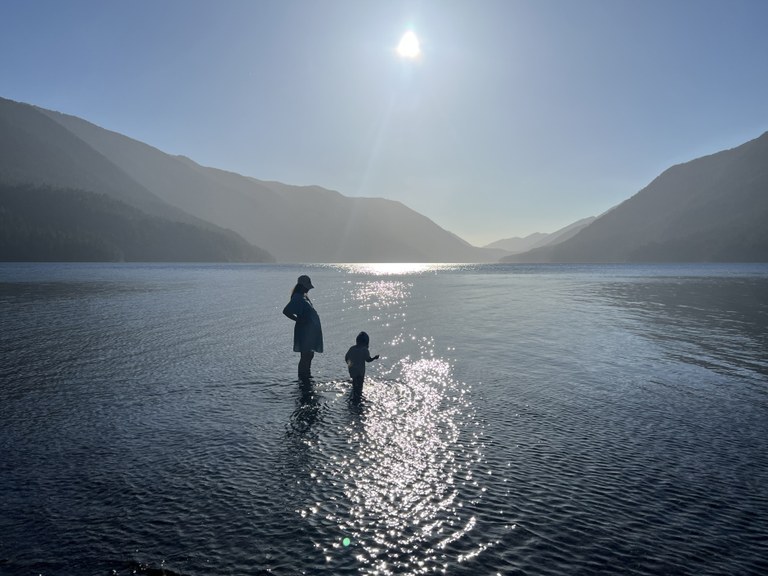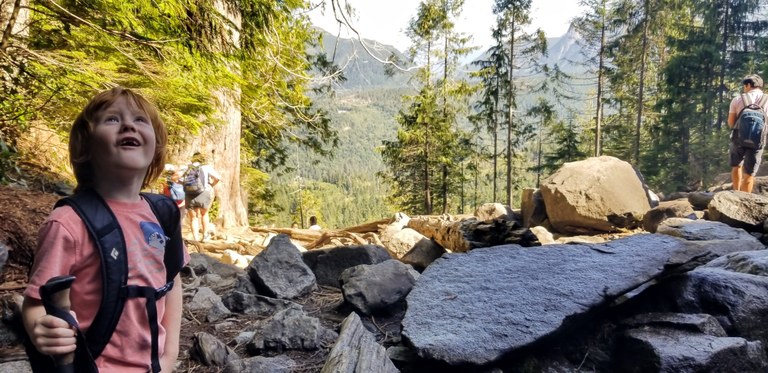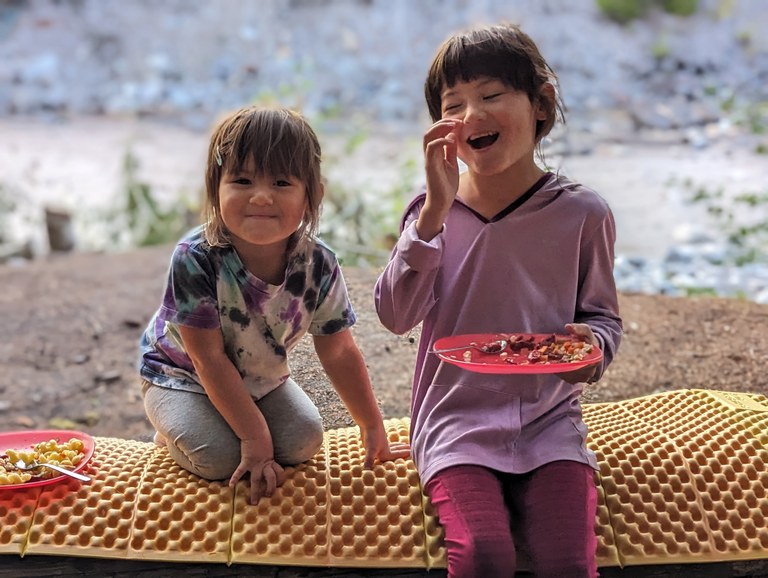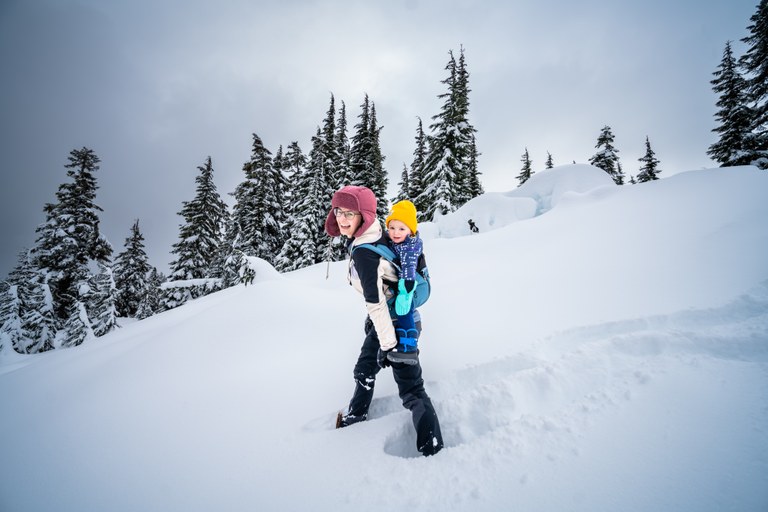 Washington Trails
Association
Washington Trails
Association
Trails for everyone, forever
Trails can help kids form a solid connection to nature. But being a parent is hard and this book offers practical tips to help get kids of all ages outside. By Linnea Johnson
As a hiker, you know that when you step onto the trail, something just feels right. If you have kids in your life, you may have seen how that shows up for them, too. When you go outside together, everything just feels a little easier.
Dr. Pooja Tandon and Dr. Danette Glassy know this feeling well, not only as a parent and grandparent, respectively, who love being outdoors with their families, but also as pediatricians and researchers. They’ve dedicated their careers to understanding the benefits of time outdoors for kids’ health and to putting their findings into action as fierce advocates for children’s access to nature.

“As a mom raising two boys, especially in those early years, I found that parenting was easier when we were outdoors. We all really enjoyed being together, and we were able to engage in healthy behaviors together. I think it is a really promising and under-tapped opportunity for families to engage in something together that promotes all of their health,” Pooja said.
However, in recent decades, opportunities for kids to be outdoors have decreased, even as robust evidence of the importance of nature for kids continues to stack up.
“As time has rolled on, more and more evidence has supported that children’s health can be supported through time in nature. And yet, what we were seeing among our families and our friends and specifically our patients was this divide … so many competing priorities and barriers were keeping them from accessing that time outdoors,” Danette said.
Those barriers are numerous and are often baked into the structures of our culture and society, from a lack of free time due to long work hours, to inequitable access to parks. Majority-BIPOC (Black, Indigenous, people of color) neighborhoods tend to have less tree canopy and access to green space than predominantly White neighborhoods, due to the historical practice of redlining and ongoing systemic racism in housing and zoning policies.
“So, Pooja and I got together to hone the tools that would help parents face some of the barriers to time in nature for kids,” Danette said.
In their new book “Digging Into Nature,” Danette and Pooja show why being in nature is so good for kids and families. They also provide practical insights to help parents work more nature time into their children’s lives, as well as activities to make the most of that time outdoors. Their ideas are conveniently broken down by developmental stage, from infancy through the teenage years. Additionally, they offer activities that are attuned to a variety of cultural backgrounds and include adaptations for parents of children with special health care needs.

The evidence is overwhelming: Being in nature provides countless benefits to kids’ physical, mental and emotional health. And in “Digging Into Nature,” Danette and Pooja present these benefits in ways that are accessible and actionable.
For example, spending time outside encourages physical activity in ways that boost kids’ mood and self-esteem, setting the stage for an active life. It’s mentally stimulating and physically demanding in ways that promote quality sleep at night. Daily time in nature and breaks outdoors can help reduce the risk of nearsightedness.
In 2020, Pooja’s research team conducted a survey of 1,000 U.S. parents during the height of the COVID-19 pandemic. Families that lived within a 10-minute walk of a park reported better mental health among both children and parents.
However, according to the Trust for Public Land, one in three Americans lack access to a park within 10 minutes of their home. Pooja and her colleagues at the Trust for Public Land are working to change that with the 10-Minute Walk Program, which calls upon mayors to accelerate the creation of parks that support equitable, healthy and thriving communities.
While some of these benefits may feel intuitive for hikers, the peer-reviewed research Danette and Pooja cite throughout “Digging Into Nature” is critical when asking policymakers for increased funding for parks, trails and programs that expand access to the outdoors.
 Giving kids time on trail is one way to let them connect to nature. And nature is good for kids mental health. Photo by Daniel Larsen.
Giving kids time on trail is one way to let them connect to nature. And nature is good for kids mental health. Photo by Daniel Larsen.
Nature has long been shown to help kids and teens reduce stress and recover from traumatic experiences. But more often pediatricians are seeing a new form of stress affecting kids as young as elementary school: climate change anxiety. In addition to the immediate stress of natural disasters, like wildfires and the resulting smoke, young people are experiencing ongoing emotional distress due to the negative changes to the environment caused by climate change.
Early research suggests that participating in efforts to care for nature, like ecological restoration or trail work, can help alleviate these emotions.
“There are all the benefits of being in nature and moving in nature, but when you’re doing something that’s restorative to the Earth, there’s a different sort of connection it forms for the young person, or any person. It can play a role in that climate grief or climate anxiety because it can engender hope. It can engender this idea that ‘I am part of the solution,’” Pooja said.
Danette noted that Tribes are leading the way on creating opportunities to give back to the land.
“As we were researching this book, I found that, all across the country, Tribal nations are promoting and holding ecological restoration events for their communities and are inviting the broader community to come together,” Danette said.

Kids’ access to nature matters to everyone — because all children deserve to experience the joy and health benefits of time in nature and because the future of our shared world is in their hands.
Whether or not you have kids in your life, people like you who love the outdoors can play a key role in expanding kids’ access to nature. By taking action, we can build a world that has more green spaces and where all families feel welcome in the outdoors.
“We know that having parks or having green spaces does not mean that people are going to go there and use them ... so, what does that next step look like? How do you help people feel like they belong there? How do you help them feel joy there? Feel confident navigating those places?” Pooja said.
Pooja and Danette encourage people who are comfortable in the outdoors to serve as “nature mentors.”
“If you’re a person who’s very comfortable on trails or engaging in any sort of nature activity, like camping or backpacking, think about those in your life — it could be your kids’ or your grandkids’ friends or neighbors — who maybe don’t know what opportunities are out there. Could they borrow some equipment? Could they tag along with you?” Pooja said.
Danette encourages nature mentors to think outside the box with activities and programming.

Whether or not you're a parent, you can look for ways to give the kids in your community a chance to get outside. Photo by Kevin Rabuck.
“Don’t discount the littlest kids. Make sure newborns to 3-year-olds are accounted for and programmed for. Think outside traditional hours as well — since some families work two jobs, is there a night get-together? Especially in the PNW, it gets dark so early (in the winter), so stretch your thoughts on when you can access nature with others,” Danette said.
On a systemic level, Pooja and Danette encourage all of us to look for opportunities to leverage our influence for more green spaces and nature time, whether that be in schools, community organizations, faith-based groups, local governments or beyond.
“That could be through your school board, through having a meeting with somebody at your school about what kinds of opportunities are available to your children. Call out when recess is canceled or ask for after-school clubs that can encourage outdoor activities,” Pooja said.
Collective action for kids’ access to nature works. For example: In recent decades, recess time in Washington has shrunk, with some kids getting as little as 10 minutes of recess per day. Just as a mental and behavioral health crisis was on the rise, kids were losing their opportunity to play, social time and physical activity outdoors. So, families, educators, organizations and pediatricians like Pooja came together as part of the King County Play Equity Coalition to speak up for recess. In 2023, their efforts paid off: The Washington State Legislature passed a law requiring at least 30 minutes of recess for elementary school children, discouraging the withholding of recess as punishment and more. That law just went into effect this fall.
Check out “Digging Into Nature,” then look for ways to speak up for equitable access to nature in your community.